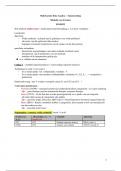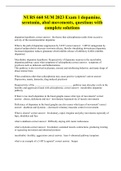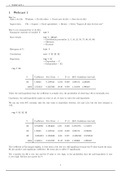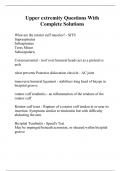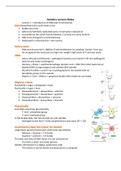Literature Developing for Markets
Lecture 1: Outside-In View on Innovation
® Crossan , Mary M., and Marina Apaydin (2010), A Multi-Dimensional Framework of Organiza-
tional Innovation: A Systematic Review of the Literature, Journal of Management Studies, 47,
6 (September), 1154-1191.
® Almquist, Eric, John Senior, and Nicolas Bloch (2016), The Elements of Value, Harvard Busi-
ness Review, September, 47-53.
Lecture 2: Understanding Customers
® Poetz, Marion K., and Martin Schreier (2012), The Value of Crowdsourcing: Can Users Really
Compete with Professionals in Generating New Product Ideas?, Journal of Product Innovation
Management, 29 (2), 245-256.
® Hamdi-Kidar, Linda, Peter Keinz, Emmanuelle Le Nagard, and Eric Vernette (2019), Comparing
Lead Users to Emergent-Nature Consumers as Sources of Innovation at Early Stages of New
Product Development, Journal of Product Innovation Management, 36 (5), 616–631.
® Madsbjerg, Christian, Mikkel B. Rasmussen (2014), An Anthropologist Walks into a Bar..., Har-
vard Business Review, 92, 3 (March), 80-88.
Lecture 3: Involving Customers
® Hauser, John R., Songting Dong and Min Ding (2014), Self-Reflection and Articulated Con-
sumer Preferences, Journal of Product Innovation Management, 31 (1), 17–32.
® Mahr, Dominik, Annouk Lievens, and Vera Blazevic (2014), The Value of Customer Cocreated
Knowledge during the Innovation Process, Journal of Product Innovation Management, 31 (3),
599– 615.
® Chang, Woojung, and Steven A. Taylor (2016), The Effectiveness of Customer Participation in
New Product Development: A Meta-Analysis, Journal of Marketing, 80 (1), 47-64.
Lecture 4: Managing New Product Ideas
® Nakata, Cheryl, Gaia Rubera, Subin Im, Jae H. Pae, Hyun Jung Lee, Naoto Onzo, and
Heungsoo Park (2018), New Product Creativity Antecedents and Consequences: Evidence
from South Korea, Japan, and China, Journal of Product Innovation Management, 35 (6), 939-
959.
® Kock, Alexander, Wilderich Heising, and Hans Georg Gemünden (2015), How Ideation Portfolio
Management Influences Front-End Success, Journal of Product Innovation Management, 32
(4), 539–555.
® Sukhov, Alexandre, Antti Sihvonen, Johan Netz, Peter R. Magnusson, and Lars E. Olsson
(2021), How Experts Screen Ideas: The Complex Interplay of Intuition, Analysis, and Sense-
making, Journal of Product Innovation Management, 38 (2), 248-270.
Lecture 5: Customer Focus in Innovation Management
® Narver, John C., Stanley F. Slater, and Douglas L. MacLachlan (2004), Responsive and Pro-
active Market Orientation and New-Product Success, Journal of Product Innovation Manage-
ment, 21 (5), 334-347.
® Drechsler, Wenzel, Martin Natter, and Peter S.H. Leeflang (2013), Improving Marketing’s Con-
tribution to New Product Development, Journal of Product Innovation Management, 30 (2), 298-
315.
® Weber, Benjamin, and Sven Heidenreich (2018), When and With Whom to Cooperate? Inves-
tigating Effects of Cooperation Stage and Type on Innovation Capabilities and Success, Long
Range Planning, 51 (2), 334-350.
,Lecture 6: Managing Market Acceptance
® Anderson, James C., James A. Narus, and Wouter van Rossum (2006), Customer Value Prop-
ositions in Business Markets, Harvard Business Review, 84 (3), 90-99.
® Gourville, John T. (2006), Eager Sellers & Stony Buyers, Harvard Business Review, 84 (6), 99-
106.
® Heidenreich, Sven, and Tobias Kraemer (2016), Innovations – Doomed to Fail? Investigating
Strategies to Overcome Passive Innovation Resistance, Journal of Product Innovation Man-
agement, 33 (3), 277-297.
Lecture 7: Developing a Market-Sensing Capability
® Mukerjee, Kaushik (2013), Customer-Oriented Organizations: A Framework for Innovation,
Journal of Business Strategy, 34 (3), 49-56.
® Bharadwaj, Neeraj, and Yuexiao Dong (2014), Toward Further Understanding the Market-
Sensing Capability-Value Creation Relationship, Journal of Product Innovation Management,
31 (4), 799-813.
® Moorman, Christine, and George S. Day (2016), Organizing for Marketing Excellence, Journal
of Marketing, 80 (6), 6-35.
,Lecture 1: Outside-In View on Innovation
Almquist, Eric, John Senior, and Nicolas Bloch (2016), The Elements of Value, Harvard Business
Review, September, 47-53.
Introduction
When customers evaluate a product or service, they weigh its perceived value against the asking price.
What consumers truly value, however, can be difficult to pin down and psychologically complicated.
Discrete choice analysis – which stimulated demand for different combinations of product features,
pricing, and other components – and similar research techniques are powerful and useful tools to man-
age value or devise ways to deliver more of it, whether functional (saving time, reducing cost) or emo-
tional (reducing anxiety, providing entertainment). Coming up with new concepts requires anticipating
what else people might consider valuable.
A rigorous model of consumer value allows a company to come up with new combinations of value that
its products and services could deliver. The right combinations pay off in stronger customer loyalty,
greater consumer willingness to try a particular brand, and sustained revenue growth.
The authors have identified 30 “elements of value” – fundamental attributes in their most essential and
discrete forms (see exhibit “The Elements of Value Pyramid”). These elements fall into four categories:
The Elements of Value Pyramid
, Maslow argued that human actions arise from an innate desire to fulfil needs ranging from the very
basic (security, warmth, food, rest) to the complex (self-esteem, altruism). Almost all marketers today
are familiar with Maslow’s hierarchy. Marketers have seen his hierarchy organized in a pyramid. At the
bottom are the physiological and safety needs, and at the top are self-actualization and self-transcend-
ence. The popular assumption has been that people cannot attain the needs at the top until they have
met the one below. Maslow himself took a more nuanced view, realizing that numerous patterns of
fulfilment can exist.
Similarly, the elements of value pyramid is a heuristic model – practical rather than theoretically perfect
– in which the most powerful forms of value live at the top. To be able to deliver on those higher-order
elements, a company must provide at least some of the functional elements required by a particular
product category. But many combinations of elements exist in successful products and services today.
Growing Revenue
To test whether the elements of value can be tied to company performance, the authors collaborated
with Research Now to survey more than 10,000 U.S. consumers about their perceptions of nearly 50
U.S.-based companies. Each respondent scored one company on each element, using a 0-10 scale.
They then looked at the relationships among these rankings, each company’s Net Promoter Score
(NPS) – metric used for customer loyalty and advocacy – and the company’s recent revenue growth.
® Hypothesis 1: The companies that performed well on multiple elements of value would have
more loyal customers than the rest.
Confirmed by the survey. Companies with high scores (defined as an 8 or above) on four or more
elements from at least 50% of respondents had, on average, three times the NPS of companies with
just one high score, and 20 times the NPS of companies with none. More is clearly better, however, it’s
obviously unrealistic to try to inject all 30 elements into a product or service. Companies must choose
their elements strategically.
® Hypothesis 2: The companies doing well on multiple elements would grow revenue at a faster
rate than the others.
Strong performance on multiple elements does indeed correlate closely with higher and sustained rev-
enue growth. Companies that scored high on four or more elements had recent revenue growth four
times greater than that of companies with only one high score.
® Hypothesis 3: The elements of value could shed light on the astonishing market share growth
of pure-play digital retailers.
This was confirmed empirically. Amazon, for instance, achieved high scores on eight mostly functional
elements, illustrating the power of adding value to a core offering. For example, in creating Amazon
Prime, in 2005, the company initially focused on delivering reduces cost and saves time by providing
unlimited two-day shipping for a flat $79 annual fee. Then it expanded Prime to include streaming media
(provides access and fun/entertainment), and other features. Each new element attracted a large group
of consumers and helped raise Amazon’s services far above commodity status. Eventually, that allowed
the company to raise Prime’s annual fee to $99 in 2015 – a large price increase by any standard.
Patterns of Value
To help companies think about managing the value side of the equation more directly, the authors
wanted to understand how the elements translate to successful business performance. They used their
data to identify three patterns of value creation:


